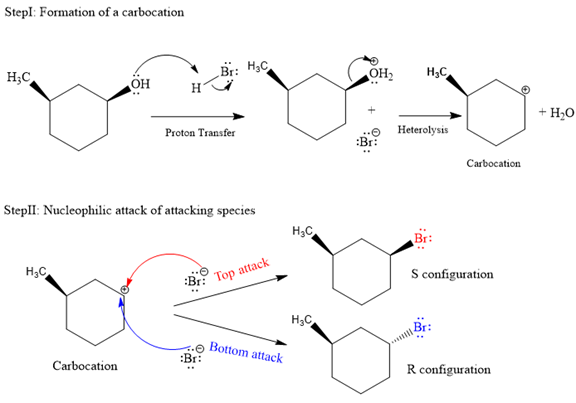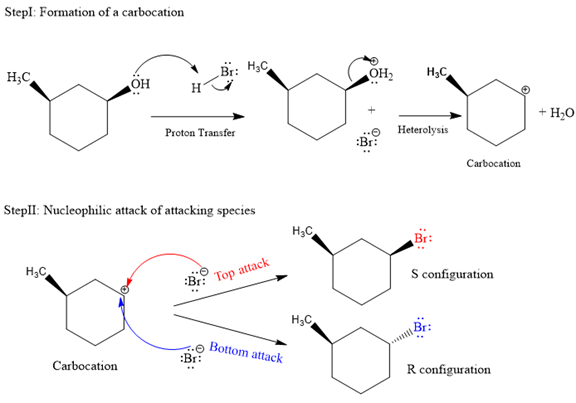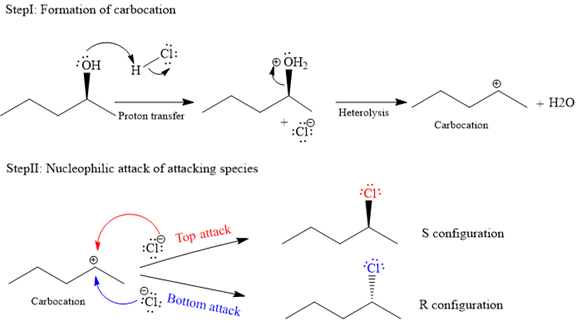
Concept explainers
(a)
Interpretation:
The complete and detailed mechanism is to be drawn for the given reaction.
Concept introduction:
The SN1 is an abbreviation for unimolecular nucleophilic substitution reaction. These reactions are two-step reactions. The first step is the formation of carbocation intermediate, followed by the nucleophilic attack, which is a second step. Due to the formation of a planar carbocation, the incoming nucleophile can attack the carbocation from two sides, either from the front of the plane or from the back side of the plane.
This leads to give the mixture of stereoisomers. When secondary and tertiary alcohols are treated with strong concentrated acids, it follows SN1 and E1 mechanism.
Answer to Problem 10.1P
The complete and detailed mechanism for given reaction is as follows:

Explanation of Solution
The given reaction is as follows:

The hydroxyl (
The departure of water is a slow step that leads to formation of carbocation, and thus it is the rate-determining step. Due to the formation of planar carbocation intermediate, the incoming nucleophile can attack from either sides, either the top (from above the plane) or bottom (from below of plane). The bromide ion formed in the proton transfer step is the attacking species in the second step of the mechanism. In the second step, the bromide ion (
Both top and bottom attack of nucleophile are possible leads to formation of the mixture of isomers, as shown below:

Due to the formation of carbocation intermediate in SN1 reaction, a mixture of stereoisomer is produced.
(b)
Interpretation:
The complete and detailed mechanism is to be drawn for the given reaction.
Concept introduction:
The SN1 is an abbreviation for unimolecular nucleophilic substitution reaction. These reactions are two-step reactions. The first step is the formation of carbocation intermediate, followed by the nucleophilic attack of attacking species, which is a second step. Due to the formation of a planar carbocation, the incoming nucleophile can attack the carbocation from two sides, either from the front of the plane or from the back side of the plane.
This leads to give the mixture of stereoisomers. When secondary and tertiary alcohols are treated with strong concentrated acids, it follows SN1 and E1 mechanism.
Answer to Problem 10.1P
The complete and detailed mechanism for given reaction is as follows:

Explanation of Solution
The given reaction is as follows:

The hydroxyl (
Both top and bottom attack of nucleophile are possible leads to formation of the mixture of isomers, as shown below:

Due to the formation of carbocation intermediate in SN1 reaction, a mixture of stereoisomer is produced.
Want to see more full solutions like this?
Chapter 10 Solutions
ORG CHEM W/ EBOOK & SW5 + STUDY GUIDE
- H I T H HH H -H C. H- Identify and select all structures below that represent a constitutional isomer(s) of the compound shown above. H- H CIH H H H HHHH H H 0 ·H H– 冊 CH CHI HH C- H- H H- H H A. H H C H H- -H HH H B. H- -H D. H H H H • H -H E. -H H H HICH T HHH F. H-arrow_forwardPolylactic acid (shown below) is a biodegradable polymer used for food packaging. Identify the monomer(s) used in the production of this polymer using a condensation process.arrow_forwardDraw the product of the reaction shown below. Ignore small byproducts that would evaporate pleasearrow_forward
- Poly(ethylene adipate) is a biodegradable polyester (shown below). Identify the type of polymerization process used in the production of this polymer.arrow_forwardPolymers may be composed of thousands of monomers. draw two repeat units(dimer) of the polymer formed in this reaction. assume there are hydrogen atoms on the two ends of the dimer. ignore inorganic byproducts pleasearrow_forwardDraw the product of the reaction shown below. Use a dash or wedge bond to indicate stereochemistry of substituents on asymmetric centers, Ignore inorganic byproductsarrow_forward
- Draw the product of this reaction please. Ignore inorganic byproductsarrow_forwardOne of the pi molecular orbitals of 1,3-butadiene (CH2=CHCH=CH2) is shown below. Please identify the number of nodal planes perpendicular to the bonding axisarrow_forwardDraw the monomers required to synthesize this condensation polymer please.arrow_forward
- Provide the correct systematic name for the compound shown here. Please take into account the keyboard options belowarrow_forwardcurved arrows are used to illustrate the flow of electrons. using the provided starting and product structures, draw the curved electron-pushing arrows for the following reaction or mechanistic step(s)arrow_forwardIdentify the 'cartoon' drawing of the acceptor orbital in the first mechanistic step of an electrophilic addition reaction of butadiene with HBr. Pleasearrow_forward
 Organic Chemistry: A Guided InquiryChemistryISBN:9780618974122Author:Andrei StraumanisPublisher:Cengage Learning
Organic Chemistry: A Guided InquiryChemistryISBN:9780618974122Author:Andrei StraumanisPublisher:Cengage Learning
